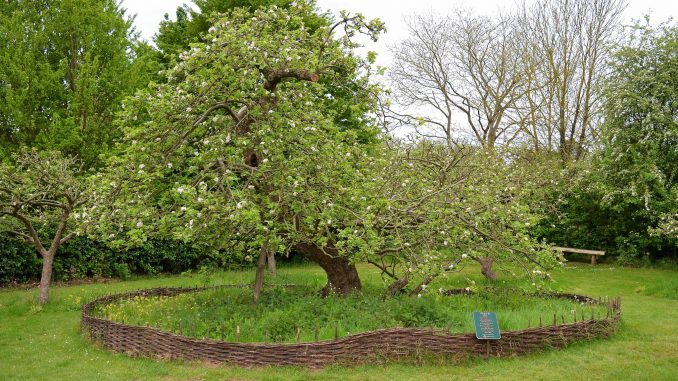
An old and gnarled apple tree at Woolsthorpe Manor in Lincolnshire, England would be interesting but not particularly noteworthy if it happened to live in any other place at any other time. One particular tree however happens to have played a central role in one of the greatest scientific discoveries in the history of history. Woolsthorpe Manor, is the familial home Isaac Newton, and that little old tree is possible the most famous tree in the world.
Newton’s apple tree holds a special place in the annals of science. In 1665, the just-graduated Newton fled to his family home to avoid a plague outbreak. While on his plague induced break from university, it was at his home of Woolsthorpe Manor where he did some of the most revolutionary math and physics of his age. It is said that after observing an apple fall from a then-young tree, Newton considered what force could pull objects in a straight line towards the earth. It was the first step towards his theory of gravity, which he would publish in 1687.
The apple tree that inspired Isaac Newton to work on law of universal gravitation is still alive after more than 400 years. Secured with a small fence and attended by professional gardeners, the Newton Apple Tree is cared for by National Trust for Places of Historic Interest or Natural Beauty.
A shoot of the tree was taken to nearby Belton Park in 1820 and the Fruit Research Station in East Malling took part of that tree in the 1930s. It’s from that second small piece that many of the Newton Apple Trees around the world have sprouted.
There are now Newton Apple Trees on every continent except Antarctica, and some universities even have their own little groves in case one should happen to get sick. There are several clones growing at the Parkes Observatory in Australia and one famous and well-loved clone at the Massachusetts Institute of Technology.
The story of the apple tree is widely considered to be false but it has become over time an integral part of the folk lore of Newton’s legacy. While he may have embellished his story a bit, Newton himself did say that his theory arose from seeing a falling apple while he stayed at Woolsthorpe. He went so far as to tell the story to his biographers and both William Stukeley and John Conduitt recorded it in their writings.
Despite all of its fame, Newton’s apple tree is a little worse for wear. It is after all more than 400 years old. The tree partially collapsed after a storm in 1816 and some of the fallen tree was made into a chair. There have also over the years been pieces taken as souvenirs.
Isaac Newton Apple Tree Facts
- The tree was planted sometime around 1650 (exact date unknown).
- Isaac Newton’s Apple Tree is located on the grounds of Woolsthorpe Manor.
- The famous tree is a rare variety known as Flower of Kent.
- The fruit of the tree is edible but said to be somewhat flavorless and mealy.
- There are descendants and clones of the Woolsthorpe Manor tree on every continent, except Antarctica.
- A genetically identical tree is growing at Newton’s alma mater, Trinity College, Cambridge.
- Seeds from Newton’s tree even visited the International Space Station in 2016, making it one of history’s most well-traveled trees.
- The tree first put down roots around 400 years ago. For at least 240 years it has been shown to visitors as Isaac Newton’s apple tree.
- Woolsthorpe Manor is a Grade I listed building.


